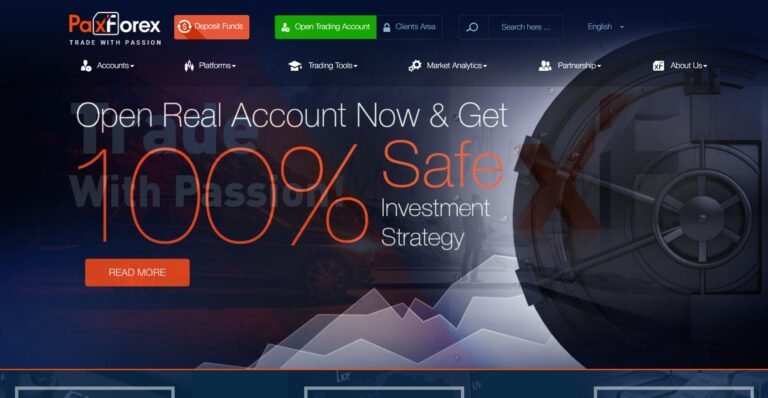Table of Contents
Introduction to PaxForex
This in-depth PaxForex review is created for traders who are suspicious or angry after a potential scam encounter. PaxForex claims to offer competitive spreads, fast execution, and access to popular trading platforms like MetaTrader 4. Headquartered in Saint Vincent and the Grenadines, PaxForex operates as an offshore entity with minimal regulatory oversight.
The question we aim to answer today is direct: Is PaxForex a scam or a legitimate trading platform? Whether you’ve already lost money or you’re second-guessing before investing, this PaxForex review uncovers all the warning signs you need to know.
PaxForex: Regulation & Legal Status
PaxForex is not regulated by any well-known financial authority. While the company is registered in Saint Vincent and the Grenadines, this jurisdiction is infamous for being a haven for high-risk and often unregulated brokers. There’s no oversight from trusted bodies like the U.S. SEC, FCA, ASIC, or CySEC.
This lack of regulation poses major risks: no legal protection for clients, no transparent dispute resolution process, and no financial compensation in case the broker collapses. Despite claims on its website, PaxForex does not provide the kind of investor safety that top-tier brokers offer.
This is a tactic we’ve seen from other shady brokers—using offshore registration to avoid accountability while luring in unsuspecting traders with professional-looking websites. Learn how to spot a scam broker before it’s too late.
The absence of a credible license raises serious concerns about whether PaxForex is a scam operating under a false sense of legitimacy.
Trading Conditions & Platform Analysis of PaxForex
PaxForex advertises three main account types: Cent, Mini, and Standard—with minimum deposits starting at $10 and leverage up to 1:500. While that sounds flexible, the extremely high leverage and lack of negative balance protection could easily wipe out accounts in volatile markets.
They offer the MetaTrader 4 platform, but again, this alone doesn’t prove legitimacy. Any broker—regulated or not—can offer MT4. PaxForex doesn’t clearly state whether it operates under an STP (Straight Through Processing) or ECN (Electronic Communication Network) model, and there’s no transparency regarding liquidity providers.
Details like execution speed, slippage, and order fill policies are conveniently vague. Traders are left in the dark about whether they’re trading against the market—or the broker itself. What to check before signing up with a trading platform includes transparency in all these areas, and PaxForex falls short.
These gaps in transparency and exaggerated trading conditions make it harder to dismiss the concern that PaxForex might be a fraud rather than a genuine broker.
Reputation & User Reviews About PaxForex
User reviews on TrustPilot paint a mixed picture. Many of the positive comments are vague and lack detailed experience—an indication they may not be authentic. This pattern of possibly fake testimonials is a common trick used by scam operations to build false credibility.
Verified complaints include difficulty withdrawing funds, accounts being frozen after successful trades, and unresponsive customer support. Several users reported being pressured into depositing more funds after initially trying to withdraw—classic signs of a broker running a manipulation scheme.
According to SimilarWeb, PaxForex’s website has low engagement, with high bounce rates and short session durations—further evidence that users may be getting frustrated or suspicious once they land on the site.
How to Test Whether PaxForex Is a Scam
Wondering how to tell if PaxForex is a scam? Here’s a practical guide:
- Verify regulatory claims. Check if PaxForex is listed with top-tier regulators like the SEC, FCA, or ASIC. Spoiler: It isn’t.
- Identify red flags. Vague license info, excessive leverage, and missing operational details are big warnings.
- Read real user reviews. Use forums like Forex Peace Army or TrustPilot to filter fake reviews from genuine ones. Look for repeat complaints on withdrawals and support.
- Test the site and platform. Does the interface work smoothly? Are you getting technical errors or delays in account setup? These are subtle but important clues.
- Scrutinize payment methods. Crypto-only withdrawals or excessive withdrawal fees are common in fraudulent setups.
- Watch out for “guaranteed profits.” No real broker makes such claims—if they do, it’s bait.
- Try the demo account. A legitimate broker allows full access to a demo version without asking for deposits or personal documents right away.
These steps can help you stay ahead of scam tactics and make better decisions before risking any money.
Final Verdict & Alternatives
After reviewing all the data, it’s clear that PaxForex presents more risks than benefits. Its offshore registration, lack of transparency, suspicious reviews, and user complaints combine to form a troubling picture. Is PaxForex a scam? While it may not be an outright fraud, the red flags are significant enough to advise extreme caution—or complete avoidance.
If you’re already a victim, don’t stay silent. File a complaint at FTC’s fraud portal and consult a financial recovery specialist. You may also research on ScamDoc’s PaxForex rating for further evaluation.
Looking for safer alternatives? Consider brokers like IG, Pepperstone (regulated AU version), or FXCM—fully licensed and transparent operations with strong investor protection.
In today’s volatile markets, trust is everything. Only trade with brokers that are regulated, transparent, and accountable.


